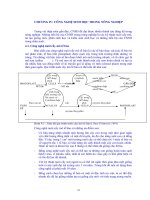Giáo trình công nghệ sinh học - australian
Bạn đang xem bản rút gọn của tài liệu. Xem và tải ngay bản đầy đủ của tài liệu tại đây (467.6 KB, 31 trang )
Australian
Biotechnology
a national strategyAustralian
Biotechnology
a national strategy
Australian Biotechnology
2
© Commonwealth of Australia 2000
ISR 2000/036
ISBN 0 642 72028 2
This work is copyright. Apart from any use as permitted under the Copyright Act
1968, no part may be reproduced by any process without prior written permission
from the Commonwealth available through AusInfo. Requests and inquiries
concerning reproduction and rights should be addressed to the Manager, Legislative
Services, AusInfo, GPO Box 1920, Canberra ACT 2601.
Design and production: Big Island Graphics and Corporate Communications.
Printing: Paragon Printers Australasia
MINISTERIAL INTRODUCTION 4
BIOCOG FOREWORD 6
GOVERNMENT'S VISION FOR
AUSTRALIAN BIOTECHNOLOGY 7
AUSTRALIA'S OPPORTUNITY AND CHALLENGE 8
What is Biotechnology? 8
International Pace of Change in Biotechnology 9
Why Biotechnology is Important to Australia 9
Australia's Biotechnology Assets 10
Challenges for Australian Biotechnology 11
Development of the National
Biotechnology Strategy 11
BIOTECHNOLOGY IN THE COMMUNITY 13
Raising Public Awareness and Informing
a Community Dialogue 13
Consideration of Ethical Issues 14
Impacts of Agriculture and Food Biotechnology
on Rural and Regional Australia 14
Pursuing Australia’s Health Objectives 15
Sustainability and Public Good Applications of
Biotechnology 15
ENSURING EFFECTIVE REGULATION 16
Developing a Rigorous, Efficient and Transparent
Regulatory System 16
Environmental Risk Assessment 17
BIOTECHNOLOGY IN THE ECONOMY 18
Addressing the Commercialisation Gap 18
Developing Biotechnology Networks and Clusters 19
Strengthening Intellectual Property Management 19
Applying Biotechnology in Australian Industry 20
AUSTRALIAN BIOTECHNOLOGY IN THE
GLOBAL MARKET. 21
Biotechnology International Marketing and
Investment Promotion 21
Improving the Assessment of Developments
in Food Markets 22
Maintaining an Active Role in International Fora 22
International Research Cooperation 23
RESOURCES FOR BIOTECHNOLOGY 24
Human Resources for Biotechnology
Development 24
National Biotechnology Research Cooperation 25
Research for Competitive and Sustainable
Agriculture Production and Food Processing 25
Access to Biological and Genetic Resources 26
MAINTAINING MOMENTUM AND COORDINATION 27
Biotechnology Australia and Australian
Biotechnology Advisory Council 27
Australian Biotechnology
3
Contents
O
n behalf of my colleagues
on the Commonwealth
Biotechnology Ministerial
Council, I am pleased to present
the National Biotechnology
Strategy which outlines the
Government's vision and support
for biotechnology.
Biotechnology is a key technology
of the future. It presents
enormous opportunities as well
as great challenges.
Biotechnology holds the promise
of improved health and welfare
for all Australians through better
understanding of disease,
improved diagnosis, and
treatment with more specific
biopharmaceutical products.
Biotechnology, including the
genetic modification of
agricultural and food products,
also has the potential to deliver
productivity, competitiveness and
sustainability benefits to
Australia. The technology offers
improved resistance to insects
and disease, and new uses for
agricultural products, improved
food qualities, reduced
environmental impact and
bioremediation are all possible.
Australia has developed world
class strengths in biotechnology-
related medical, agricultural and
environmental research. We must
build on these strengths for the
responsible development and
management of biotechnology in
Australia. Through biotechnology
we are developing innovative
products, building fast-growing
enterprises, attracting
international investment and
creating high value employment.
The Government will work to
ensure that Australians have
access to the skills and
knowledge they need to keep
pace with this global revolution.
We believe it is also important to
safeguard the health of our
community and the environment
and that Australia is well served
by a range of regulators who are
working together to provide
assurance that biotechnology is
safe for our country.
The Government ensures rigorous
human health and environmental
assessment of GMO releases, and
will undertake research to improve
the knowledge base and manage
risks in the field.
The National Biotechnology
strategy provides a framework for
Government, working with key
stakeholders, to capture the
benefits of biotechnology
development for Australia. The
strategy addresses the present
situation in a rapidly changing
environment, and will be a living
document, able to address new
challenges as they arise.
Australian Biotechnology
4
Australian Biotechnology
5
The Hon
Dr David Kemp
Minister for
Education,Training
and Youth Affairs
The Hon
Dr Michael
Wooldridge
Minister for
Health and
Aged Care
The Hon
Warren Truss
Minister for
Agriculture,
Fisheries and
Forestries
Senator The Hon
Robert Hill
Minister for the
Environment
and Heritage
Senator The Hon
Nick Minchin
Chairman
Biotechnology
Ministerial
Council and
Minister for
Industry Science
and Resources
Ministerial
Introduction
T
he Biotechnology
Consultative Group
(BIOCOG) supports the
Government's vision to develop a
National Biotechnology Strategy
and has contributed to its
formulation over the last year. The
issues which require the greatest
attention include:
◗ Ensuring effective regulation
of biotechnology research and
application.
◗ Providing balanced
information to the public on
biotechnology issues.
◗ Addressing the critical gap in
early stage funding and
management and the creation
of competitive biotech clusters.
Global biotechnology innovation
and growth continues to
accelerate. The United States,
Canada, UK, and Germany, for
example, are reaping tremendous
benefits from major government
programs and growing private
sector commitments to develop
industries utilising biotechnology.
Effective commercialisation of the
technologies developed in
Australia is necessary to generate
a return from our investment and
participate in the global
biotechnology marketplace. The
potential rewards are enormous:
one biotech-based
pharmaceutical, erythropoietin,
generated world-wide market
sales in excess of $A5 billion in
1999, equivalent to the total
world export sales of Australian
gold in that year.
We believe that biotechnology-
based technologies and
industries will create new high
value employment, generate
health and environmental
benefits, and provide a strong
basis for continued economic
growth. These are important
priorities for Government. A
requisite step will be enhanced
cooperation between the
Commonwealth, the States,
research organisations, and the
private sector.
Tony Bates
Chair,
Biotechnology Consultative Group
The Biotechnology Consultative
Group was formed in 1999 to
advise Biotechnology Australia
and the Commonwealth
Biotechnology Ministerial Council
on the development of the
National Biotechnology Strategy.
The Group consists of 22
members from the research and
business sectors, including
ethicists and nutritionists.
Australian Biotechnology
6
Foreword by the Biotechnology
Consultative Group
C
onsistent with safeguarding
human health and ensuring
environmental protection, that
Australia capture the benefits of
biotechnology for the Australian
community, industry and the
environment.
This vision, which is based on the
responsible use of biotechnology
to drive economic and
community benefit, is supported
by the Government’s goals for
biotechnology which are:
◗ To ensure that in research into,
and in applications of
biotechnology
– human health and the
environment are
safeguarded, in particular
through a rigorous, efficient
and transparent system of
regulation for gene
technology research and for
genetically modified
organisms and products;
and
– the highest ethical
standards are observed.
◗ To ensure that the community
has access to quality
information about
biotechnology, the potential
risks and benefits of its
applications, the ethical issues
they raise, and has confidence
in the way risks are assessed
and managed
– and that it can contribute to
public policy in this area.
◗ To enhance the economic and
community benefits of
biotechnology through
– an internationally
competitive environment
for investment and
enterprise development;
– stronger links between the
biotechnology research
sector and industries that
apply biotechnology; and
– better management of
intellectual property.
◗ To maintain and develop the
infrastructure for generating
biotechnology applications
through
– productive investment in
biotechnology research and
development;
– world class education in
biotechnology;
– secure access to genetic and
biological resources; and
– conserving genetic and
biological resources.
Australian Biotechnology
7
Government's Vision for
Australian Biotechnology
What is
Biotechnology?
Biotechnology is a broad term for
a group of technologies based on
the application of biological
processes. It has diverse
applications in medicine,
agriculture, food processing,
manufacturing and
environmental management. The
term "modern biotechnology" is
used to distinguish recent,
research based activities from
traditional fermentation
technologies such as bread,
cheese or beer making, and
animal and plant breeding, which
were the first examples of
biotechnology. Modern
biotechnology includes a range of
techniques from recombinant
DNA technology, molecular and
cellular biology, biochemistry and
immunology through to
information technology. Gene
technology is a specific subset of
biotechnology, based on the
manipulation and modification
("recombination") of the genetic
material of living organisms to
develop new characteristics,
processes and products.
Biotechnology is a powerful
enabling technology, with
applications that have the
potential to revolutionise many
industry sectors including
agriculture, forestry, fishing,
pharmaceuticals and health,
chemicals, textiles, food
processing, environmental
industries, energy and mining.
Biotechnology is already
responsible for a growing range
of new and better treatments for
common diseases.There are more
than 350 biotechnology drug
products and vaccines currently in
human clinical trials, more than a
hundred products already on the
market and hundreds more in
early development in the United
States alone. These medicines are
designed to treat various cancers,
Alzheimer's disease, heart
disease, diabetes, multiple
sclerosis, AIDS, obesity and other
conditions.
Australian Biotechnology
8
Australia's Opportunity
and Challenge
There are now more than
100 biotechnology-based
pharmaceutical products
on the market and 350 in
development.
Biotechnology is responsible for
hundreds of medical diagnostic
tests that detect diseases earlier,
thereby ensuring more successful
treatment, and that keep the
blood supply safe from viruses.
Home pregnancy tests are also
biotechnology diagnostic
products. In the foreseeable
future biotechnology promises to
enable the prediction and early
prevention of many diseases,
developments that will radically
reshape the health industry.
International
Pace of Change in
Biotechnology
Biotechnology development
around the world is moving fast.
It is less than 20 years since the
launch of the world’s first
biotechnology medicine, an
insulin product, in 1982. In 1998
Australian farmers first used
cotton plants which had been
genetically modified to be pest
resistant, which has enabled
them to reduce their use of
pesticides.While biotechnology
will continue to be dependent on
lengthy research and
development efforts, we are now
on the threshold of a major
expansion in the number and
commercial value of applications.
In 1999, total biotechnology
revenues in the United States
increased by 16% to $US18.6
billion. The 1283 biotechnology
companies in the US spent
$US9.9 billion on R&D in 1999
and increased employment by 9%
to 153,000. Europe and Canada
have experienced equally
impressive ongoing growth and
major Japanese companies have
invested heavily in biotechnology
for the food and pharmaceutical
industries.
Why Biotechnology is
Important to Australia
Australia’s industrial
competitiveness, and hence our
standard of living, will be strongly
influenced by whether we can
grasp the opportunities
presented by biotechnology, and
underpinned by the knowledge
and skills of our researchers.
Biotechnology promises to be the
next great wave of technological
change, bringing changes as
radical and pervasive as those
wrought by the IT revolution.
Australia is at the forefront of
these developments.We have an
excellent institutional base, and a
number of innovative small
companies which, given the right
circumstances, could lead the
growth of the new industries.
Australian Biotechnology
9
Biotechnology derived
pregnancy kits are
assisting in early and
simple detection.
An environment that encourages
responsible biotechnology
development, and fosters
investment in infrastructure, R&D
and commercialisation will drive
economic growth and maximise
Australia’s opportunities to be a
producer and exporter of key
technologies.
Australia's
Biotechnology Assets
Australia has substantial research
infrastructure in the universities,
the CSIRO, Co-operative Research
Centres and Commonwealth and
State funded research and
development organisations.
Commonwealth expenditure on
biotechnology research and
development is in excess of $250
million per year through a range
of programs, with private sector
spending of a similar order.
Australia has a robust and
internationally compatible
intellectual property protection
system. This is particularly
important in an area where
research and development are
expensive, require long lead times
and products are focussed on
global markets.
Australia has a sound regulatory
framework on which to base its
management of the risks and
ethical issues associated with
genetic research.
The Australian biotechnology
sector has registered some
significant successes in recent
years that are contributing to
industry and investor confidence.
Most of the more than 130 core
biotechnology companies in
Australia are small, with high
levels of research and
development spending.
There has been an increase in the
supply of venture capital in recent
years, encouraged in part by
government policy; but the
demand for capital is growing
even more strongly. Changes to
the Capital Gains Tax provisions
are expected to significantly
improve the availability of
venture capital in Australia.
Most of the major multinational
pharmaceutical and agribusiness
firms are active in Australia, and
have research collaborations with
local firms and research
organisations.
Australian Biotechnology
10
Government invests over
$250m per year in
biotechnology R&D.
Challenges for
Australian
Biotechnology
Australia has a strong foundation
for developing and applying
biotechnology. We have a very real
opportunity to be a significant
participant in this dynamic global
industry - an opportunity to
capture health and
environmental benefits, to
develop new enterprises, new
industries, new bases for
competitiveness in existing
industries and new international
collaborative relationships.
In some sectors, for example
agriculture and mining, Australia
enjoys significant comparative
advantage. However our
comparative advantage in such
areas may face serious challenge
if we do not capitalise on the
innovations offered through
biotechnology. In others sectors
where we do not currently enjoy
particular advantages - such as
pharmaceuticals, health and
environmental industries -
biotechnology offers substantial
opportunities to improve our
competitive position. The
challenge will be to seize these
opportunities.
Australian firms often lack the
financial depth and the
management and market
expertise to take a product from
invention to market; much
biotechnology intellectual property
is licensed to overseas companies.
Such partnerships can be valuable
and will continue to be important.
But we are not always capturing
the maximum commercial and
community benefits arising from
our research. Australia faces a
challenge to extract more value
from its intellectual property and
investment in R&D.
Genetic research and its
application also open significant
ethical and consumer issues and
there are potential risks to the
environment which need to be
managed. The Australian
community needs to be engaged
in an informed debate on the
ethical and regulatory issues. A
challenge for Australian
biotechnology will be to work
with the community and earn its
confidence as consumers and
investors.
Development of the
National
Biotechnology
Strategy
Australian investment in modern
biotechnology began in the 1980s
and broadened in the 1990s.
Biotechnology is now a
significant element of
Commonwealth research,
training, innovation, regulatory
and business support programs.
These programs, along with
examples of the activities they
support, are outlined in the
publication: Australian
Biotechnology: Progress and
Achievements.
In 1999 the Government
established Biotechnology
Australia and the Commonwealth
Biotechnology Ministerial Council
to coordinate government
biotechnology activity and to
develop a national biotechnology
strategy. The Government also
Australian Biotechnology
11
established the Biotechnology
Consultative Group (BIOCOG), a
panel of experts from industry
and the scientific and research
community, to provide
independent advice to
government.
The strategy, which builds on the
current substantial
Commonwealth support for
biotechnology, seeks to:
◗ Capitalise on our existing
advantages in biotechnology.
◗ Achieve sustainable growth for
established and new industry
sectors.
◗ Strengthen coordination
among Commonwealth
Government activities and
partnerships with State
Governments.
◗ Build on industry commitment
and active participation.
◗ Develop a catalytic role for
government.
◗ Provide a basis for ongoing
consultation and strategy
development.
In developing the National
Biotechnology Strategy the views
of stakeholders were sought
through an extensive
consultation process. A
Discussion Paper "Developing
Australia's Biotechnology Future"
was published in September
1999, submissions were invited
and forums were held in all
capital cities. Considerable input
was received from a wide range of
organisations and from many
individuals. BIOCOG and
representatives of the States and
Territories provided additional
advice and consultation on
development of the National
Biotechnology Strategy. Members
of BIOCOG also provided valuable
input, along with industry
experts, on issues such as the
commercialisation of public
sector research. In addition, a
range of background studies were
carried out by Biotechnology
Australia or commissioned from
independent consultants.
In the area of regulation of
biotechnology, effective
community consultation was
achieved by the Interim Office of
the Gene Technology Regulator
(IOGTR) gathering community
input into draft legislation and
related matters.
The National Biotechnology
Strategy addresses the six key
themes that emerged from
consultations and assessments:
◗ Biotechnology in the
Community,
◗ Ensuring Effective Regulation,
◗ Biotechnology in the Economy,
◗ Australian Biotechnology in
the Global Market,
◗ Resources for Biotechnology,
and
◗ Maintaining Momentum and
Coordination.
Australian Biotechnology
12
Raising Public
Awareness and
Informing a
Community Dialogue
Objective
Increase the public’s general
awareness of biotechnology and its
applications, and of the regulations
that safeguard people and the
environment in order to facilitate
informed debate and decisions.
Consumers are seeking balanced
information on biotechnology
ranging from the basics of gene
technology to details of the
regulatory processes. The issue of
genetically modified food appears
to be a particular concern. There is
a strong preference from the
community for the Government
to be the primary source of
information on gene technology.
In order that there is public
confidence in biotechnology, it is
essential that the community
continue to contribute to the
development of Government
policy.
Strategies
◗ Engage the community in
discussion of regulatory
processes, including testing
and labelling of GM foods, and
assessing and managing risks
to human health and the
environment.
◗ Build community confidence in
biotechnology, its regulation,
the industry, and the way risks
are assessed and managed.
◗ Inform consumer discussions
and listen to community
concerns.
◗ Encourage public contribution
to policy decisions.
Australian Biotechnology
13
Overall objectives
◗ Increase the public’s general
awareness of biotechnology
and its applications, and of
the regulations that
safeguard people and the
environment in order to
enable informed debate and
decisions.
◗ Address ethical concerns
relating to biotechnology
research and to its potential
applications.
◗ Address the concerns of rural
and regional Australia about
agricultural and food
biotechnology, including
potential socio-economic
effects of biotechnology, and
manage any adverse
impacts.
◗ Pursue the economic and
community benefits of
improved health through
biotechnology.
◗ Ensure recognition of the
capacity of biotechnology
research to address
sustainability and natural
resource management issues.
Biotechnology in the Community
Biotechnology can improve
rural sustainability and
competitiveness.
Consideration of
Ethical Issues
Objective
Address ethical concerns relating
to biotechnology research and to
its potential applications.
Modern biotechnology raises
significant ethical issues which
need to be addressed and openly
discussed.
Strategies
◗ Consult and liaise widely with
the community on ethical
issues.
◗ Strengthen and enhance
ethical standards and existing
approaches to ethical issues.
Impacts of Agriculture
and Food
Biotechnology on Rural
and Regional Australia
Objective
Address the concerns of rural and
regional Australia about
agricultural and food
biotechnology, including potential
socio-economic effects of
biotechnology, and manage any
adverse impacts.
Biotechnology has direct
implications for rural and regional
Australians including the impact
of the technology upon the
viability of the family farm, the
local community and related
businesses. These concerns will
require on-going attention as the
issues evolve with the technology.
Strategies
◗ Identify and address relevant
issues for rural and regional
Australians through continued
monitoring and public
awareness activities.
◗ Identify, monitor and assess
the opportunities and
challenges of biotechnology-
related changes in the
agriculture and food industries
to inform policy responses.
Australian Biotechnology
14
Biotechnology could help
control feral animals with
enhanced protection of
endangered species.
Strategy
◗ Strengthen Australia’s
expertise in medical genomics
and biotechnology within our
existing health and medical
research sector.
Sustainability and
Public Good
Applications of
Biotechnology
Objective
Ensure recognition of the capacity
of biotechnology research to
address sustainability and natural
resource management issues.
Pursuing Australia’s
Health Objectives
Objective
Pursue the economic and
community benefits of improved
health through biotechnology.
The Australian Health System is
having to respond to an ageing
population and the associated
demands that places on our
health budget. Biotechnology can
contribute to better health care
by improving our knowledge of
the basis of health and disease
and offering better treatment
options in some areas. For
example, an early and accurate
diagnosis of disease can both
improve patient health and lead
to significant health savings.
The capacity of biotechnology to
contribute to environmental
sustainability, natural resource
management, and protection of
biodiversity has not been fully
recognised. It is important to
recognise and publicise the public
benefits of much biotechnology
research.
Strategy
◗ Develop indicators to measure
the public benefits that
biotechnology can deliver in
sustainability, natural resource
management and biodiversity
conservation and publicise
these benefits.
Australian Biotechnology
15
Biotechnology research is
improving our knowledge
of disease and could lead
to better treatment.
Biotechnology
applications have the
potential to address
agricultural and
environmental issues,
including salinity.
Developing a
Rigorous, Efficient
and Transparent
Regulatory System
Objective
Establish a permanent Office of
the Gene Technology Regulator
(OGTR) and develop associated
legislation.
Currently, there is a range of
regulatory agencies which control
genetically modified organisms
and their products, depending on
the end use. Genetically modified
foods are controlled by the
Australia New Zealand Food
Authority (ANZFA), GM medicines
by the Therapeutic Goods
Administration (TGA), GM
agricultural and veterinary
chemicals by the National
Registration Authority (NRA), GM
industrial chemicals by the
National Industrial Chemical
Notification Assessment Scheme
(NICNAS), and border control is
managed by the Australian
Quarantine and Inspection
Service (AQIS) and Australian
Customs Service (ACS). There is
also an expert advisory
committee, the Genetic
Manipulation Advisory
Committee (GMAC), which
provides advice to these agencies
and oversees the research and
development stage of genetically
modified organisms.
As the technology develops, new
issues arise that are not covered
by other regulatory agencies. For
Australian Biotechnology
16
Overall objectives
◗ Establish a permanent
Office of the Gene
Technology Regulator
(OGTR) and develop
associated legislation.
◗ Institute a system that
ensures that potential risks
from the introduction of
genetically modified
organisms (GMOs) are
accurately assessed and are
managed effectively.
Ensuring effective regulation
The Therapeutics Goods
Administration (TGA) is one of
the partners that regulates
genetically modified products
and organisms.
this reason, the Government has
announced that it will establish a
permanent Office of the Gene
Technology Regulator and
associated legislation by January
2001. This Office will replace the
advisory system of GMAC and
complement the other regulatory
agencies. The Office will provide a
greater level of transparency and
accountability at the research and
development stage and will also
have a coordinating function to
minimise regulatory duplication.
Strategies
◗ In collaboration with the
States and Territories introduce
a nationally enforceable
system of regulation that
safeguards the community
and the environment against
possible risks, while
acknowledging the
commercial needs of the
biotechnology industry.
◗ Consult with Commonwealth
agencies, State and Territory
governments, and a broad
range of non-government
stakeholders to determine how
ethical and socio-economic
issues can be incorporated in
the regulatory process.
Environmental Risk
Assessment
Objective
To institute a system that ensures
that potential risks from the
introduction of genetically
modified organisms (GMOs) are
accurately assessed and are
managed effectively.
Regulatory decision-making for
gene technology should be based
on sound scientific risk
assessment. Therefore, we must
build on the system that ensures
that risks in the field have been
accurately assessed and are being
managed effectively. There is a
need to enhance monitoring
research on GMOs released into
the environment to determine if
there are any unforeseen or
unintended consequences and to
inform the regulatory process.
Strategies
◗ Establish a framework and a
methodology for risk
assessment.
◗ Identify priorities for an
environmental risk assessment
program.
◗ In collaboration with CSIRO
and other agencies, improve
basic knowledge and assess
environmental risks associated
with genetically modified
organisms.
◗ Monitor and evaluate any
impacts.
◗ Monitor the effectiveness of
the regulatory system to
ensure that it continues to
cover the field.
Australian Biotechnology
17
Potential risks from
introducing genetically
modified organisms need
to be rigorously assessed
and managed.
Addressing the
Commercialisation
Gap
Objective
Overcome the critical gap for proof
of concept funding and
management at the early stage of
product and commercial
development.
A major obstacle to the effective
commercialisation of Australia’s
high quality biotechnology R&D
is the deficiency in funding at the
pre-seed or ‘proof-of-concept’
stage of product development.
Many early stage discoveries are
not exploited, or are licensed
prematurely, because they lack
the funds needed to prove the
research concept, identify
potential markets and develop a
suitable investment proposal.
Improving biotechnology
commercialisation in Australia
will improve the returns on public
investment in R&D.
Strategy
◗ Collaborate with State and
Territory Governments and
private sector investors to
provide proof of concept funds
to increase the number of
investment-ready proposals for
venture capital funds and for
programs such as R&D Start.
Australian Biotechnology
18
Biotechnology in the Economy
Overall objectives
◗ Overcome the critical gap for
proof of concept funding
and management at the
early stage of product and
commercial development.
◗ Establish a critical mass for
biotechnology research,
commercialisation and
application through the
development of clusters,
incubators and networks.
◗ Strengthen capabilities for
the commercial and
strategic management of
Intellectual Property in
biotechnology.
◗ Promote the responsible
uptake of biotechnology for
product and process
development in industry.
Increased
commercialisation of
biotechnology requires
earlier access to
investment capital.
Developing
Biotechnology
Networks and Clusters
Objective
Establish a critical mass for
biotechnology research,
commercialisation and application
through the development of
clusters, incubators and networks.
Biotechnology research and
commercialisation are
characterised by specialist
knowledge and by collaboration
between research organisations
and industry which helps to
achieve the critical mass that is
important for major
breakthroughs and rapid
progress. Internationally these
clusters include universities and
other research organisations,
companies involved in the
development and application of
biotechnology, companies that
provide specialist inputs, and
supporting legal, financial and
business organisations. It is the
presence of these factors that
have helped develop strong
biotechnology clusters in
particular regions of the United
States, UK and Germany.
Strategies
◗ Collaborate with the States
and Territories to facilitate the
development and national
coordination of clusters and
networks.
◗ Strengthen the mechanisms
for co-operation between
research funders, research
providers and industry on
biotechnology research and
commercialisation
Strengthening
Intellectual Property
Management
Objective
Strengthen capabilities for the
commercial and strategic
management of Intellectual
Property in biotechnology.
The development of capabilities
for the effective management of
Intellectual Property (IP) is an
important element in securing
the benefits of public and private
sector research in biotechnology
for the Australian community,
industry and the environment.
Australian Biotechnology
19
Biotechnology will
improve the international
competitiveness of many
established industries.
Strategies
◗ Analyse biotechnology IP
management needs of
researchers, technology
managers and other
stakeholders, identify IP
management requirements for
key export markets, and
support development of pilot
programs to address these
needs.
◗ Identify impediments caused
by R&D lead times and
regulatory delays that may
affect the effective patent life
of biotechnology innovations.
◗ Promote opportunities for
research and industry groups
to share experiences in IP
management from innovation
through to commercialisation.
Applying
Biotechnology in
Australian Industry
Objective
Promote the responsible uptake of
biotechnology for product and
process development in industry.
The major economic benefits
from a new technology arise from
its rapid and widespread diffusion
into the broader industrial
community. As an enabling
technology, biotechnology will
have a major impact on the
competitiveness of many firms in
such established industries as
forestry, environmental
management, food processing,
mining and chemicals.
Strategies
◗ Encourage access to
biotechnology by Australian
industries.
◗ Generate specific
biotechnology market sector
information.
◗ Ensure innovative approaches
to farm/industry extension for
agriculturalists to understand
the issues and the strict
requirements on the use of the
technology.
◗ Encourage the development
and operation of segregated
supply chains for food
products.
◗ Undertake technology
foresight studies to identify
technological and commercial
trends and opportunities.
◗ Promote biotechnology
demonstration projects that
lead to the integration of
modern biotechnology into
existing industry.
Australian Biotechnology
20
Australia has a growing
number of innovative
biotechnology
companies.
Biotechnology
International
Marketing and
Investment Promotion
Objective
Attract essential foreign
investment and development
partners to add commercial value
to Australian biotechnology R&D
and to develop key overseas
markets.
Australian biotechnology
development often requires
international commercial partners
for investment in research
commercialisation, product
development, regulatory approval
and marketing. There is a need to
raise international awareness of
the growing opportunities in
Australia for collaboration and
investment in biotechnology R&D
and commercialisation within
Australia.
Strategies
◗ Coordinate Invest Australia,
Austrade, Biotechnology
Australia, State and Territory
organisations and industry
approaches to international
marketing and investment
attraction.
◗ Identify Australian
biotechnology trade and
investment opportunities.
◗ Promote Australian
biotechnology sector
capabilities in key overseas
markets.
Australian Biotechnology
21
Australian Biotechnology
in the Global Market
Overall objectives
◗ Attract essential foreign
investment and development
partners to add commercial
value to Australian
biotechnology R&D and to
develop key overseas
markets.
◗ Develop understanding of
the changes in domestic and
international markets for
genetically modified and
non-GM agriculture and
food products and improve
management of product
identification.
◗ Ensure decisions in
international fora do not
disadvantage the trading
environment for Australian
GM agriculture and food
products.
◗ Strengthen Australian
collaboration with
international biotechnology
research centres and
programs and build
relationships for technology
development partnerships.
The Institute of
Molecular Bioscience is
under construction in
Brisbane.
Improving The
Assessment of
Developments in
Food Markets
Objective
Develop understanding of the
changes in domestic and
international markets for
genetically modified and non-GM
agriculture and food products and
improve management of product
identification.
Timely information on the sizes
and trends of markets for
genetically and non-genetically
modified products, and on
consumer attitudes underlying
the markets, is vital to manage
uncertainty. The issues of
segregation, preservation of
identity and certification of origin
go to the heart of any decision to
supply markets for both
genetically modified and non-
genetically modified product. A
good understanding of the
differentiation of products would
enable Australian agriculture and
food enterprises to manage and
profit from these markets.
Strategies
◗ Establish a cross-industry
export market access
committee to monitor and
report to industry and
governments on trends in
genetically modified, non-
genetically modified and co-
mingled markets.
◗ Facilitate an on-going
examination of the costs and
benefits of supplying
genetically modified product
and on establishing identity
preservation within Australia’s
major agriculture and food
industries.
Maintaining an
Active Role in
International Fora
Objective
Ensure decisions in international
fora do not disadvantage the
trading environment for
Australian GM agriculture and
food products.
International frameworks that
will shape biotechnology
patenting, regulation and trade
will be determined in ongoing
negotiations in a range of
international fora including the
Organisation of Economic
Australian Biotechnology
22
Regulatory agencies
control the use of
genetically modified
organisms such as GM
soybeans.
Cooperation and Development
(OECD), the World Intellectual
Property Office (WIPO), the World
Trade Organisation (WTO) and the
United Nations fora. Australia's
position in international fora
dealing in GM products is that
protection of human health and
environment safety can be
achieved through science-based
risk analysis without imposing
unjustified barriers to trade in
these products.
Strategies
◗ Continue to pursue a strong
presence in regional and
multilateral fora to seek
recognition and adoption of
Australia's position.
◗ Continue to work bilaterally to
ensure access to foreign
markets for Australian
agriculture and food
biotechnology products.
◗ Report regularly to industry
and governments on direction
and trade implications for the
agriculture and food sector of
international negotiations.
International
Research Cooperation
Objectives
Strengthen Australian
collaboration with international
biotechnology research centres
and programs and build
relationships for technology
development partnerships.
Linkages with major international
centres of research are vital for
the robust development of
Australian biotechnology.
Building on Australia’s strong
research capacities provides the
opportunity to participate in
international research programs -
for example, the EU Fifth
Framework Program - and to
strengthen relationships with
neighbours in the Asia-Pacific
region.
Strategies
◗ Facilitate and support
Australian participation in
international projects in key
areas such as bioinformatics,
proteomics and through access
to major research facilities.
◗ Develop biotechnology
collaboration within existing
bilateral research programs.
Australian Biotechnology
23
The pharmaceutical
industry is an early
adopter of biotechnology
innovations.









